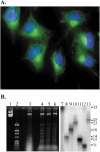CAG*CTG repeat instability in cultured human astrocytes
- PMID: 16945950
- PMCID: PMC1636369
- DOI: 10.1093/nar/gkl614
CAG*CTG repeat instability in cultured human astrocytes
Abstract
Cells of the central nervous system (CNS) are prone to the devastating consequences of trinucleotide repeat (TNR) expansion. Some CNS cells, including astrocytes, show substantial TNR instability in affected individuals. Since astrocyte enrichment occurs in brain regions sensitive to neurodegeneration and somatic TNR instability, immortalized SVG-A astrocytes were used as an ex vivo model to mimic TNR mutagenesis. Cultured astrocytes produced frequent (up to 2%) CAG.CTG contractions in a sequence-specific fashion, and an apparent threshold for instability was observed between 25 and 33 repeats. These results suggest that cultured astrocytes recapitulate key features of TNR mutagenesis. Furthermore, contractions were influenced by DNA replication through the repeat, suggesting that instability can arise by replication-based mechanisms in these cells. This is a crucial mechanistic point, since astrocytes in the CNS retain proliferative capacity throughout life and could be vulnerable to replication-mediated TNR instability. The presence of interruptions led to smaller but more frequent contractions, compared to a pure repeat, and the interruptions were sometimes deleted to form a perfect tract. In summary, we suggest that CAG.CTG repeat instability in cultured astrocytes is dynamic and replication-driven, suggesting that TNR mutagenesis may be influenced by the proliferative capacity of key CNS cells.
Figures





Similar articles
-
Expansions of CAG.CTG repeats in immortalized human astrocytes.Hum Mol Genet. 2007 Dec 15;16(24):3088-96. doi: 10.1093/hmg/ddm270. Epub 2007 Sep 19. Hum Mol Genet. 2007. PMID: 17881653
-
Maternal germline-specific effect of DNA ligase I on CTG/CAG instability.Hum Mol Genet. 2011 Jun 1;20(11):2131-43. doi: 10.1093/hmg/ddr099. Epub 2011 Mar 5. Hum Mol Genet. 2011. PMID: 21378394
-
DNA elements important for CAG*CTG repeat thresholds in Saccharomyces cerevisiae.Nucleic Acids Res. 2004 Feb 24;32(4):1289-97. doi: 10.1093/nar/gkh292. Print 2004. Nucleic Acids Res. 2004. PMID: 14982954 Free PMC article.
-
DNA repair and trinucleotide repeat instability.Front Biosci. 2003 May 1;8:s653-65. doi: 10.2741/1107. Front Biosci. 2003. PMID: 12700078 Review.
-
Trinucleotide repeat instability via DNA base excision repair.DNA Repair (Amst). 2020 Sep;93:102912. doi: 10.1016/j.dnarep.2020.102912. DNA Repair (Amst). 2020. PMID: 33087278 Free PMC article. Review.
Cited by
-
Large-scale expansions of Friedreich's ataxia GAA•TTC repeats in an experimental human system: role of DNA replication and prevention by LNA-DNA oligonucleotides and PNA oligomers.Nucleic Acids Res. 2023 Sep 8;51(16):8532-8549. doi: 10.1093/nar/gkad441. Nucleic Acids Res. 2023. PMID: 37216608 Free PMC article.
-
Tissue- and age-specific DNA replication patterns at the CTG/CAG-expanded human myotonic dystrophy type 1 locus.Nat Struct Mol Biol. 2010 Sep;17(9):1079-87. doi: 10.1038/nsmb.1876. Epub 2010 Aug 15. Nat Struct Mol Biol. 2010. PMID: 20711191
-
MutSβ abundance and Msh3 ATP hydrolysis activity are important drivers of CTG•CAG repeat expansions.Nucleic Acids Res. 2017 Sep 29;45(17):10068-10078. doi: 10.1093/nar/gkx650. Nucleic Acids Res. 2017. PMID: 28973443 Free PMC article.
-
MATES: a deep learning-based model for locus-specific quantification of transposable elements in single cell.Nat Commun. 2024 Oct 11;15(1):8798. doi: 10.1038/s41467-024-53114-7. Nat Commun. 2024. PMID: 39394211 Free PMC article.
-
Disease-associated CAG·CTG triplet repeats expand rapidly in non-dividing mouse cells, but cell cycle arrest is insufficient to drive expansion.Nucleic Acids Res. 2014 Jun;42(11):7047-56. doi: 10.1093/nar/gku285. Epub 2014 May 23. Nucleic Acids Res. 2014. PMID: 24860168 Free PMC article.
References
-
- Paulson H.L., Fischbeck K.H. Trinucleotide repeats in neurogenetic disorders. Annu. Rev. Neurosci. 1996;19:79–107. - PubMed
-
- Mirkin S.M. Molecular models for repeat expansions. Chemtracts-Biochem. Mol. Biol. 2004;17:639–662.
-
- Pearson C.E., Edamura K.N., Cleary J.D. Repeat instability: mechanisms of dynamic mutations. Nature Rev. Genet. 2005;6:729–742. - PubMed
-
- Kovtun I.V., McMurray C.T. Trinucleotide expansion in haploid germ cells by gap repair. Nature Genet. 2001;27:407–411. - PubMed
-
- Gomes-Pereira M., Fortune M.T., Monckton D.G. Mouse tissue culture models of unstable triplet repeats: in vitro selection for larger alleles, mutational expansion bias and tissue specificity, but no association with cell division rates. Hum. Mol. Genet. 2001;10:845–854. - PubMed
Publication types
MeSH terms
Grants and funding
LinkOut - more resources
Full Text Sources
Research Materials

